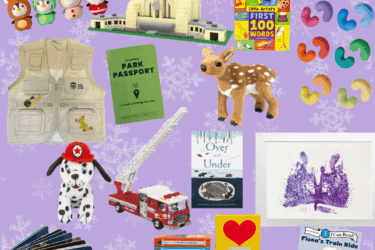In addition to feeling overwhelmed with work/home balance, ensuring our kids have a proper education and being overloaded with an abundance of information these days, parents tend to also be more and more concerned about their child’s speech and language development. The worry of your baby being developmentally delayed is common and there are many reasons why you shouldn’t be. Here’s why.
Concern is Normal
“All babies and toddlers are different and meet their milestones at different times,” says Jessica Silverman, MA, CCC-SLP, director of Speech & Language Services at Big Blue Canopy Pediatric Gym & Therapy Services. “I have many kiddos that are late talkers but early walkers, and vice versa. Their little brains are working overtime to meet these milestones and often one gets put on hold while another is mastered/achieved.”
If you find your baby isn’t babbling all of the words you had hoped, or that baby at the weekly playdate meetup is already trying to sing “Happy Birthday,” before yours, first
things first, do not compare. Parents will immediately jump to Google, aimlessly reading up on language delays and disorders if they even think for a second their baby is “behind.” Before you jump to conclusions, know that although a vast majority of kids learn language quickly, learning at such a young age does take time and practice. If you look at the big picture, it is quite amazing how they pick up words and phrases so quickly in the first place. Give them a little grace (and yourself), and if you find that time isn’t on your side, you can always turn to your pediatrician.
“I always try to let parents know that the early intervention age is incredible when it comes to listening to spoken language and learning to speak,” says Silverman. “I often make the analogy that our 0 – 3 age kiddos are like little sponges, soaking up the language that they hear and that they are exposed to on a daily basis.”
If you have turned to speech therapy and you are worried your little one is quiet initially at the start of treatment, don’t panic, assures Silverman. This is common with toddlers, and they are being far more productive than you may think.
“These kiddos are constantly soaking up the language during tasks,” she continues. “ I have had many parents tell me, ‘He/she was so quiet the entire 30 minutes with you but after we left, they said many of the words you used in therapy on the drive home.’”
How Babies Learn
Simply said, babies learn from you (and everyone else around them). One tip on helping your baby speak, is to talk, talk talk! The more you interact and speak with your baby throughout the day, the more your baby will pick up the language.
Just because language appears to be instinctive it doesn’t mean babies and toddlers don’t benefit greatly from interaction with their parents and caregivers. In fact, a baby’s day-to-day experience is so important to the process. For example, when starting the day, talk through each step at a time – every little word matters! Try saying, “We need to get dressed. First, we need to take off your jammies. I need to pull your shirt over your head …” says Silverman.
“Another activity that I tell parents to engage with at home would be narrative play or language bombardment tasks,” she continues. “This involves playing with your child and talking/narrating throughout play.”
You can say phrases such as, “The cow is hungry. Can you feed him his food? Here comes the farmer. He needs to open the gate…” Each task you engage in throughout the day provides more opportunities to expose your developing baby to new words and language concepts.
Babies are very visual as well. Drawing attention to your mouth as you say words is a great way for Baby to learn to sound them out. Have you ever watched your little’s tiny mouth try to mimic yours? They are watching and learning more than you may think. Try to hold preferred objects close to your mouth so that Baby can see how your mouth is moving to produce sounds. Repeat back sounds that your child makes to teach early conversational turn-taking.
“Making silly faces, sounds, etc. will be a fun activity for your child but also show them how your mouth is moving to make the sounds,” explains Silverman. “When your child makes sounds, try to repeat them back. This will teach them early conversational turn-taking. For example, you talk and I listen, then you say something back and I listen.”
Encouraging Baby to Talk
The earlier you expose your baby to language the better. Most babies at 3 or 4 months will be making mostly vowel sounds, for example. So this is a great time to start making repetitive consonant sounds, such as pointing to pictures and talking about “the cat, the cow and the canary,” during reading time.
If your baby isn’t speaking just yet, Silverman suggests providing pictures of preferred items. This way, your little one can grab the picture of the item they want even though they aren’t able to express that through words. “This may help decrease frustration the child might be feeling because they are not able to communicate verbally,” she says.
Teaching simple baby signs may be helpful as well. This can provide a means of communication if your child is not yet verbalizing words, she continues.
“Babies typically are able to imitate motor patterns with the body before speech/oral motor patterns with the mouth,” she explains. “I always try to pair the initial sounds (exaggerated) or words with the signs so that the child does not solely rely on only the sign to communicate.”
Speech and Language Delays
If you are worried about your baby’s speech or language development, first things first, try not to panic and ring up your pediatrician. According to the American Academy of Pediatrics’ website, healthychildren.org, there is a difference between a language and a speech. A kid with a language delay might say words well but only be able to put two words together, whereas a child with a speech delay might use words and phrases to express ideas but be hard to understand. If you are seeing this, then don’t be afraid to pick up the phone and make the call. Early intervention is key to helping your kid and a better chance for success.
If your pediatrician thinks that there may be a delay, they may refer you to a speech language pathologist (SLP). The SLP will check your child’s speech and language skills and go from there.
Resources for Baby and You
Silverman provides helpful resources you can use as you go on your language journey with Baby.
YOUTUBE: Cocomelon, Little Baby Bum, Mrs. Rachel – Great sing-along videos and more to help encourage speech development, learning ABC’s and I23’s and more.
LANGUAGE BOOKS:First 100 Words books for example – contain a variety of common objects, various language concepts, action words, etc.; great for teaching new vocabulary. Behind-the-flap Books: Helpful with targeting “what” and “where” questions while reading aloud.
TOYS: These particular toys are great with the early intervention population:
- POTATO HEAD – Teaches body parts, following directions, requesting (e.g. “put on”, “take off”, etc.)
- LITTLE PEOPLE FIGURES/ANIMALS – Teaches a variety of language concepts, producing animal sounds, identifying common objects and more.
- BUBBLES – You can use a variety of simple words with early developing speech sounds during play (e.g. “pop”, “bubble”, “go”, “open”, “up”, “down”).
- CARS/TRAINS – Work on imitating environmental sounds for the vehicles (e.g. “choo choo”, “vroom”, etc.), different spatial concepts (up, down, under, etc.) and more.
- BALL MAZE TOYS – Can request colors/objects (balls), make requests for actions (e.g. “go”, “push”, “pull”, “move”, etc).
- LOCK AND KEY TOYS – Requires kids to request help with opening doors, responding to “wh” questions (e.g. “what is in there?”, “where was the…?”, or “who was behind the door?”).





